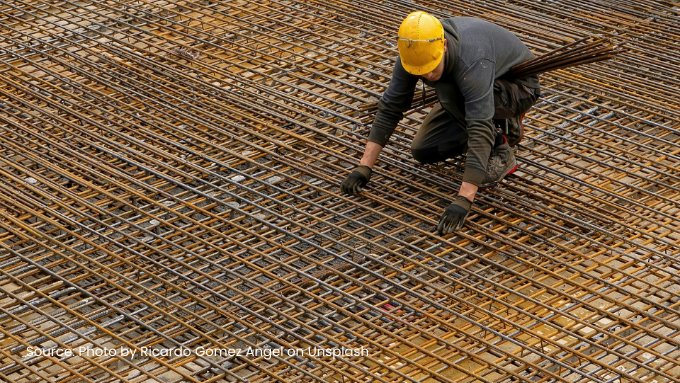Description of Work Positions and Musculoskeletal Disorder (MSDs) Complaints Among Workers in the Gresik Steel Industry
Versions
- 17-07-2024 (2)
- 30-06-2024 (1)

Downloads
Background: One of the occupational health and safety problems that many manufacturing workers experience is unergonomic work positions, this can cause fatigue and several serious diseases, including Musculoskeletal Disorder (MSDs.)
Objectives: To find out the description of work positions and MSD complaints felt by workers of Gresik Steel Industry, particularly in the area of magnetic flux leakage and rework.
Methods: This study used an observational method and analysis was carried out using the Angle Meter application, Rapid Entire Body Assessment (REBA), and the Nordic Body Map (NBM) questionnaire.
Results:The assessment of work positions shows that 2 workers have a moderate risk level, 4 workers have a high risk level, and 2 workers have a very high risk level that requires immediate improvement. The results of observations show that the work activities that are often carried out by workers are squatting positions with a bent back and neck in a flexed position, which is an unergonomic position. A total of 87.5% of workers experienced moderate MSDs complaints, and 12.5% of workers experienced low-level MSDs complaints. Control efforts that have been made include the use of tools to lift products, setting working hours and breaks, and using personal protective equipment (PPE).
Conclusion: Assessment of work positions in magnetic flux leakage and rework area workers has a high risk level that requires immediate corrective action, and MSDs complaints are felt by workers in the high category. The description of work positions can be used as a basic reference for companies to determine additional control efforts to reduce the risk of MSDs complaints among workers in the future.
BSN. (2021). Penetapan Sni 9011:2021 Pengukuran Dan Evaluasi Potensi Bahaya Ergonomi Di Tempat Kerja. Jakarta. Badan Standardisasi Nasional.
Dwi Suryanto, Rubi Ginanjar, A. F. (2020). Hubungan Risiko Ergonomi Dengan Keluhan Musculoskeletal Disorders (Msds) Pada Pekerja Informal Bengkel Las Di Kelurahan Sawangan Baru Dan Kelurahan Pasir Putih Kota Depok Tahun 2019. Promotor, 3(2), 9. Https://Doi.Org/10.32832/Pro.V3i2.4169
Evadarianto, N. (2017). Postur Kerja Dengan Keluhan Musculoskeletal Disorders Pada Pekerja Manual Handlingbagian Rolling Mill. The Indonesian Journal Of Occupational Safety And Health, 6(1), 97. Https://Doi.Org/10.20473/Ijosh.V6i1.2017.97-106
Faridah, F., & Junaidi, A. S. (2022). Faktor Yang Mempengaruhi Keluhan Musculoskeletal Disorders (Msds) Pada Pembatik Seberang Kota Jambi. Quality"¯: Jurnal Kesehatan, 16(2), 109–116. Https://Doi.Org/10.36082/Qjk.V16i2.831
Firdaus, E. J., & Sujarno, P. A. (2023). Penilaian Postur Tubuh Pekerja Dan Perbaikan Sistem Kerja Dengan Metode Rula Dan Reba Pada Pt . Sharp Electronics Indonesia. Jurnal Serambi Engineering, Viii(2), 5170–5181.
Hasanah Miftahul, & Winarko. (2019). Pengaruh Postur Kerja Terhadap Keluhan Muskuloskeletal. Gema Lingkungan Kesehatan, 17(1), 14–19. Https://Doi.Org/10.36568/Kesling.V17i1.1047
Herdiana, M. R., & Nugraha, A. E. (2023). Penilaian Risiko Postur Kerja Berdasarkan Metode Rula Pada Pekerja Manual Handling Di Toko H . Dadang. Jurnal Serambi Engineering, 8(1), 4367–4373.
Hutabarat, Y. (2017). Dasar Dasar Pengetahuan Ergonomi. In Media Nusa Creative (1st Ed.). Media Nusa Creative.
ILO. (2014). Safety And Health At Work: A Vision For Sustainable Prevention.
Irzal. (2016). Dasar-Dasar Kesehatan Dan Keselamatan Kerja (I. Fahmi (Ed.); 1st Ed.). Kencana.
Larono, B. C. D., Pinontoan, O. R., Boky, H., & Ratulangi, S. (2017). Hubungan Sikap Kerja Dengan Keluhan Musculoskeletal Disorders Pada Pekerja Buruh Di Pelabuhan Laut Manado. Kesehatan Masyarakat, 1–5.
Mallapiang, F., Azriful, Nildawati, Syarfaini, Muis, M., & Adriansyah. (2021). The Relationship Of Posture Working With Musculoskeletal Disorders (Msds) In The Weaver West Sulawesi Indonesia. Gaceta Sanitaria, 35, S15–S18. Https://Doi.Org/10.1016/J.Gaceta.2020.12.005
Meliani Dewa Ayu Sri Shita, Suyasning Hastiko, S. H. (2022). Hubungan Antara Sikap Kerja Dengan Keluhan Musculoskeletal Disorders Pada Pekerja Angkut Barang Toko Grosir Komodo Di Denpasar. Aesculapius Medical Journal, 2(3), 161–165.
Muliati. (2018). Hubungan Posisi Kerja Dengan Keluhan Musculoskeletal Disorders Pada Penenun Di Rumah Bonang Jalan Asahan Pematangsiantar Muliati. Tunas-Tunas Riset Kesehatan, 8(November), 59–71. Http://2trik.Jurnalelektronik.Com/Index.Php/2trik/Article/View/2trik8hkn12/8hkn12
Nana Rahdiana. (2017). Identifikasi Risiko Ergonomi Operator Mesin Potong Guillotine Dengan Metode Nordic Body Map (Studi Kasus Di Pt. Xzy). Industry Xplore, 2(1), 1–12.
Nilamsari, N., & Innafin, F. (2022). Identifikasi Musculoskeletal Disorder Dan Penilaian Postur Kerja Pada Pekerja Loader Semen Di Pt Swabina Gatra Identification Of Musculoskeletal Disorder And Assessment Of Work Posture On Cement Loader Workers At Pt Swabina Gatra. Jurnal Ergonomi Indonesia, 8(1), 46–56. Https://Ojs.Unud.Ac.Id/Index.Php/Jei/Article/View/87184
Oktaviani, P., Regiana, R., Satya, D., & Herliawan, A. (2022). Analisis Postur Tubuh Pekerja Pada Bagian Support Sandblasting Di Pt Po Dengan Menggunakan Metode Posture Evaluation Index ( Pei ). Jurnal Teknik Industri, 12(3), 232–239.
OSHA. (2013). Ergonomics"¯: The Study Of Work. U.S. Department Of Labor, 2000, 1–14. Www.Osha.Gov.
Paul Mangiring. (2021). Literatur Review Faktor-Faktor Yang Berhubungan Dengan Keluhan Musculoskeletal Disorders (Msds) Pada Pekerja Bagian Packing Tahun 2020. Journal Of Health Services Volume, 01, 132–136. Https://Ojs.Polbap.Ac.Id/Ojs/Index.Php/Jhs
Sholeha, N., Ratriwardhani, R. A., & ... (2022). Gambaran Keluhan Subjektif Dan Penilaian Risiko Ergonomi Menggunakan Metode Nbm Dan Rosa Pada Pengguna Komputer Di Kantor Pusat Pt. Xyz. ... Wahana Pendidikan, 8(13), 362–369. Http://Jurnal.Peneliti.Net/Index.Php/Jiwp/Article/View/2084
Sulaiman, F. And Yossi Purnama S. (2018). Analisis Postur Kerja Pekerja Proses Pengelasam Batu Akik Dengan Metode Reba. Jurnal Optimalisasi, 1(1), 32–42.
Susanti, L., Zadry, H., & Yuliandra, B. (2015). Pengantar Ergonomi Industri. In Andalas University Press.
Syati, I. A., Muslimin, B., Dedi, M., & Ali, I. (2021). Sikap Kerja Dengan Keluhan Musculoskeletal Disorders (Msds) Pada Pekerja Civil Di Pltu (2x50 Mw) Tanjung Karang, Gorontalo Utara, Gorontalo. Jurnal Kesehatan Yamasi Makasar, 5(2), 121–127.
Tanjung, S. (2015). Analisis Postur Kerja Menggunakan Metode Rula Untuk Mengurangi Risiko Musculoskeletal Disorders (Studi Kasus Pada Pekerja Di Plant Kt-24, Pt Bakrie Pipe Industries). Jurnal Ilmiah Universitas Bakrie, 3(02).
Tarwaka. (2015). Ergonomi Industri Dasar-Dasar Pengetahuan Ergonomi Dan Aplikasi Di Tempat Kerja. Harapan Press., 2.
Tiogana, V., & Hartono, N. (2020). Analisis Postur Kerja Dengan Menggunakan Reba Dan Rula Di Pt X Worker Posture Analysis Using Reba And Rula At Pt X. Journal Of Integrated System, 9–25.
Tjahayuningtyas, A. (2019). Faktor Yang Mempengaruhi Keluhan Musculoskeletal Disorders (Msds) Pada Pekerja Informal. The Indonesian Journal Of Occupational Safety And Health, 8(1), 1. Https://Doi.Org/10.20473/Ijosh.V8i1.2019.1-10
Utomo, C., Sulistiarini, E. B., & Putri, C. F. (2021). Analisis Tingkat Resiko Gangguan Musculoskeletal Disorder (Msds) Pada Pekerja Gudang Barang Jadi Dengan Menggunakan Metode Reba, Rula, Dan Owas. Prosiding Seminar Nasional Aplikasi Sains & Teknologi (Snast) 2021, 110–117.
Yudiardi, M. F., Imron, M., & Purwangka, F. (2021). Penilaian Postur Kerja Dan Risiko Musculoskeletal Disorders (Msds) Pada Nelayan Bagan Apung Dengan Menggunaan Metode Reba. Jurnal Ipteks Psp, 8(April), 14–23.
Copyright (c) 2024 saikhunuddin saikhu

This work is licensed under a Creative Commons Attribution-ShareAlike 4.0 International License.
Media Gizi Kesmas by Unair is licensed under a Creative Commons Attribution-ShareAlike 4.0 International License.
1. The journal allows the author(s) to hold the copyright and to retain the publishing right of the article without restrictions.
2. The legal formal aspect of journal publication accessibility refers to Creative Commons Attribution-Share-Alike (CC BY-SA).
3. The Creative Commons Attribution-Share-Alike (CC BY-SA) license allows re-distribution and re-use of a licensed work on the conditions that the creator is appropriately credited and that any derivative work is made available under "the same, similar or a compatible license”. Other than the conditions mentioned above, the editorial board is not responsible for copyright violations.



















